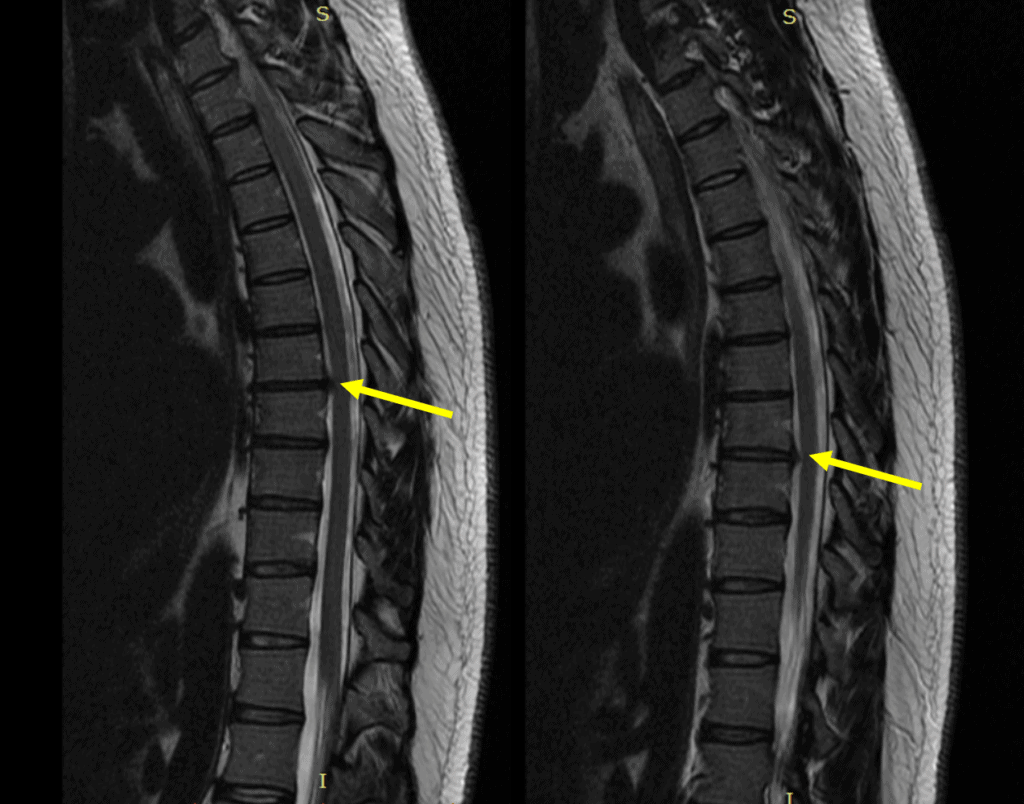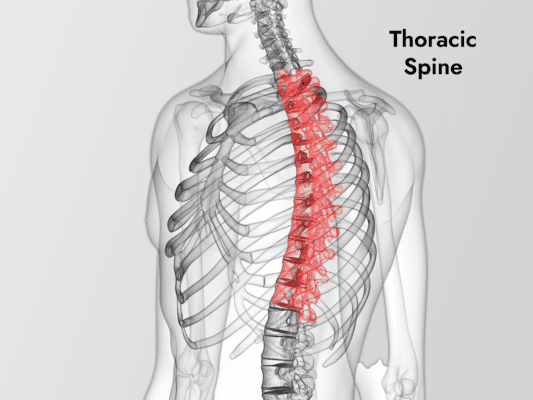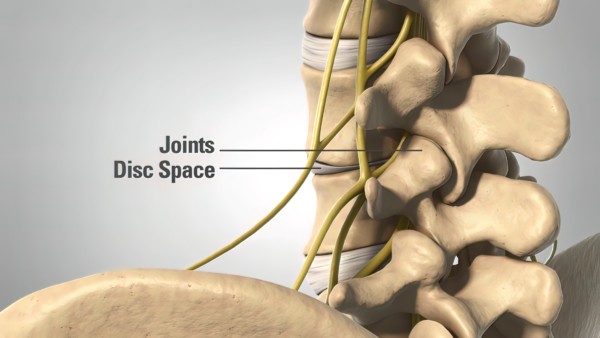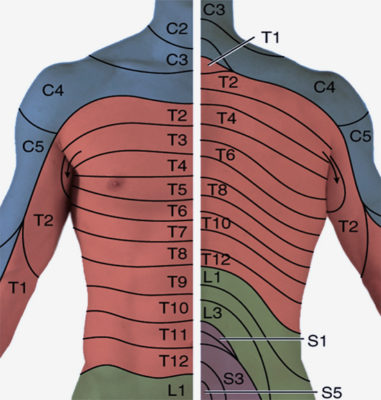What Is Thoracic Radiculopathy?
What is Thoracic Radiculopathy? How is it diagnosed and treated? Dr. Google says this one is rare, but not based on what we have seen in the past few decades of experience with this diagnosis. Let’s dig in.
What Is Thoracic Radiculopathy?
The thoracic spine is your upper back, as shown below. Radiculopathy means that a spinal nerve is misbehaving. Hence, Thoracic Radiculopathy simply means that a spinal nerve is irritated or pinched in your upper back.
The spinal nerves come out on each side and at each level of the spine. In the image below you can see that the disc is in front and the spinal nerve exists in a small hole made by the two vertebrae coming together (foramen). Behind where the nerve exits is the facet joint, which like any joint can become damaged and get arthritic. Hence, the spinal nerves can get irritated by a disc bulge or arthritis in the facet joints (1).
Another cause of Thoracic Radiculopathy can be an unstable level due to muscle atrophy. This means that the small muscles stabilizing the individual backbones aren’t working properly. This can cause the thoracic spinal nerves to get traumatized.
Another possible cause of Thoracic Radiculopathy is a compression fracture (2). This means that the vertebra bone is crushed and instead of being a square shape becomes a wedge shape. This change in shape can also irritate the spinal nerve.
What Are the Symptoms of Thoracic Spine Nerve Damage? What Does Thoracic Nerve Pain Feel Like?
The main symptoms are upper back pain that wraps around to the right or left or both sides. That can also go as far as the side or even the front of the rib cage. This pain can be sharp, dull, or electric. It can get better or worse with rotating or bending your upper back or with taking a deep breath.
An unusual presentation of this problem, but one that I have personally seen is Thoracic Radiculopathy causing abdominal pain. That’s because the lower thoracic dermatomes stripe along the belly (see dermatome map below) (3). So an irritated nerve in the lower thoracic area can cause radiating pain in the abdomen.
How Is Thoracic Radiculopathy Diagnosed? What Can a Thoracic MRI Detect?
Most of the time Thoracic Radiculopathy is diagnosed with a combination of history and exam plus a thoracic MRI. An MRI can detect a disc bulge or arthritis that might irritate a nerve (see below MRI image showing bulges). However, this is where some patients may experience issues in getting properly diagnosed.
Most physicians are very comfortable with neck and lower back issues. However, many never really perform a proper examination of the thoracic spine. Let’s dig in there a bit.
For example, there are spinal nerves that supply the skin as shown above. Each stripe across has a letter and number, so T2 means the second thoracic spinal nerve. The location where the pain/numbness/tingling wraps around can therefore pinpoint which thoracic level we should pay attention to on MRI or in treatment. However, few physicians perform an examination of these areas. What would that look like?
A proper thoracic exam uses a pinwheel where the doctor goes up and down on your upper back looking for areas that feel less or more. These areas that feel different can be linked to irritated spinal nerves. How many physician specialists out of 100 perform this exam? Very, very few.
How Do You Treat Thoracic Nerve Pain?
This is where the average patient can run into some problems. The first line of treatment is usually conservative measures like physical therapy, chiropractic, acupuncture, etc… It’s the second and third lines of treatment where patients may run into problems.
As shown above, in the exam section, most physicians treat the neck and back but skip over the thoracic area. Why? Let’s go into the technical difficulties in treating the upper back with injections and surgeries.
For injections and surgeries, the presence of the lungs in this area really makes procedural care more technically demanding. For example, a common treatment for thoracic radiculopathy would be an epidural steroid injection. However, for every 100 interventional spine physicians that perform x-ray guided lumbar or cervical epidurals with some frequency, few of them perform thoracic epidurals. Why? Avoiding the lung makes this procedure much more technically challenging, so few doctors take the extra time to learn the technique.
The same issues make surgery in this area difficult (4). Meaning that to get at a thoracic disc bulge to remove it, the surgeon usually has to purposefully delate the lungs, which makes the procedure require a stay in the ICU, which is atypical for spinal disc surgery. Hence, most surgeons avoid surgeries in this area (5).
One Patient’s Story Using Newer Orthobiologic Injections

Brad is a twenty-something with a 20-year history of severe upper back pain every few months since injuring his upper back in high school wrestling. During these flare-ups, he would have wrap-around pain that could be made worse with breathing. His MRI above demonstrated a thoracic disc bulge at T6-T7 and T7-T8. His exam showed decreased sensation with a pinwheel in these spinal nerve areas and tenderness along the ribs there. Rather than injecting him with steroids, which can be potent anti-inflammatories, but also damage tissue, we chose to use his own blood platelets (PRP). To learn more about orthobiologics like platelet-rich plasma (PRP), see my video below:
Why did we treat this area when so many physicians avoid it like the plague? Because it’s become an area of expertise for some of our clinics including our HQ in Colorado. Meaning we have done thousands of x-ray and ultrasound-guided thoracic injections.
Brad had a single epidural injection of platelet growth factors, around the disc bulge areas as well as into the beat-up fascial coverings of the ribs and into atrophied stabilizing muscles at these levels. At 3-4 months out, despite helping two people move (something that would always set off severe pain), he has no pain or problems.
The upshot? Thoracic Radiculopathy happens but is often ignored. I hope this review helps patients get to a diagnosis and effective treatment!
____________________________________
References:
(1) Han S, Jang IT. Prevalence and Distribution of Incidental Thoracic Disc Herniation, and Thoracic Hypertrophied Ligamentum Flavum in Patients with Back or Leg Pain: A Magnetic Resonance Imaging-Based Cross-Sectional Study. World Neurosurg. 2018 Dec;120:e517-e524. doi: 10.1016/j.wneu.2018.08.118. Epub 2018 Aug 24. PMID: 30149175.
(2) Philips GAC, Oshima Y, Inoue H, et al. Full-endoscopic spine surgery for radiculopathy after osteoporotic vertebral compression fractures: a case report. J Spine Surg. 2020;6(2):466-471. doi:10.21037/jss.2019.10.11
(3) Ishii M, Nishimura Y, Hara M, et al. Thoracic Disc Herniation Manifesting as Abdominal Pain Alone Associated with Thoracic Radiculopathy. NMC Case Rep J. 2020;7(4):161-165. Published 2020 Sep 15. doi:10.2176/nmccrj.cr.2019-0247
(4) Haufe SM, Baker RA, Pyne ML. Endoscopic thoracic laminoforaminoplasty for the treatment of thoracic radiculopathy: report of 12 cases. Int J Med Sci. 2009;6(4):224-226. Published 2009 Aug 12. doi:10.7150/ijms.6.224
(5) Wichmann TO, Bazys M, Gudmundsdottir G, Carlsen JG, Duel P, Valancius K, Katballe N, Rasmussen MM. Outcome and negative events in thoracic disc herniation surgery: a Danish registry study. Br J Neurosurg. 2020 Dec 21:1-6. doi: 10.1080/02688697.2020.1861429. Epub ahead of print. PMID: 33345627.

If you have questions or comments about this blog post, please email us at [email protected]
NOTE: This blog post provides general information to help the reader better understand regenerative medicine, musculoskeletal health, and related subjects. All content provided in this blog, website, or any linked materials, including text, graphics, images, patient profiles, outcomes, and information, are not intended and should not be considered or used as a substitute for medical advice, diagnosis, or treatment. Please always consult with a professional and certified healthcare provider to discuss if a treatment is right for you.


